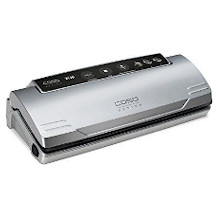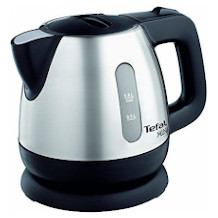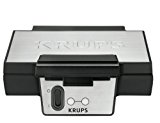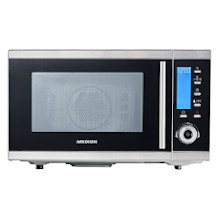Bread slicer purchasing advice: how to choose the right product
- What You Need to Know
- Bread slicers cut various foods such as bread, sausage and cheese quickly and cleanly into even slices.
- Bread slicers are either manually or electrically operated. There are machines that are permanently installed and foldable models.
- All-purpose slicers carry a high risk of injury. Therefore, careful handling and reliable safety settings are a top priority.
The advantages of a bread slicer
Pre-sliced bread quickly becomes dry and loses its flavour. The same applies to sausage or cheese. Freshly cut from the loaf, it simply tastes better. When consumers use a knife and cutting board, the slices often become uneven: either they turn out too thick or they get holes in them.
With the use of a bread slicer, such inconveniences are a thing of the past. The useful kitchen helper saves users time and effort, as a bread slicer, also known as an all-purpose slicer, works both quickly and cleanly and, above all, cuts even slices. However, all-purpose slicers also need a place in the kitchen.
Some bread slicers are foldable and can be stored in the cupboard when not in use. Other bread slicers, especially larger and high-quality slicers, are permanently installed, which is advantageous for frequent use – for example in the catering trade.
How do bread slicers work?
The basic principle of bread slicers is based on a round cutting blade, which is operated either electrically or by a hand crank. Users place the material to be sliced, for example bread or sausage, on a movable guide rail and guide it past the blade. The blades of the universal slicer cut the food evenly and, in the best case, without tearing the bread, sausage or cheese. Manufacturers usually offer different types of blades for different foods. High-quality all-purpose slicers come with serrated blades as well as serrated and smooth special blades. Incidentally, consumers can regulate the desired thickness of the slices themselves; there is usually a wheel on the side of the universal slicer for this purpose. This setting is important on bread slicers because a slice of sausage should not normally be as thick as a slice of bread.
Manual or electric machines?
There are two different categories of bread slicers, namely manually operated bread slicers with a hand crank and bread slicers with an electric motor. The mechanical bread slicers are particularly suitable for beginners who want to familiarise themselves with an all-purpose slicer first, and for consumers who have to manage without electricity, for example in a garden shed.
Manual bread slicers
Pro Points
- Consume no electricity
- Inexpensive
Drawbacks
- Operated by physical force
- High effort required for hard foods
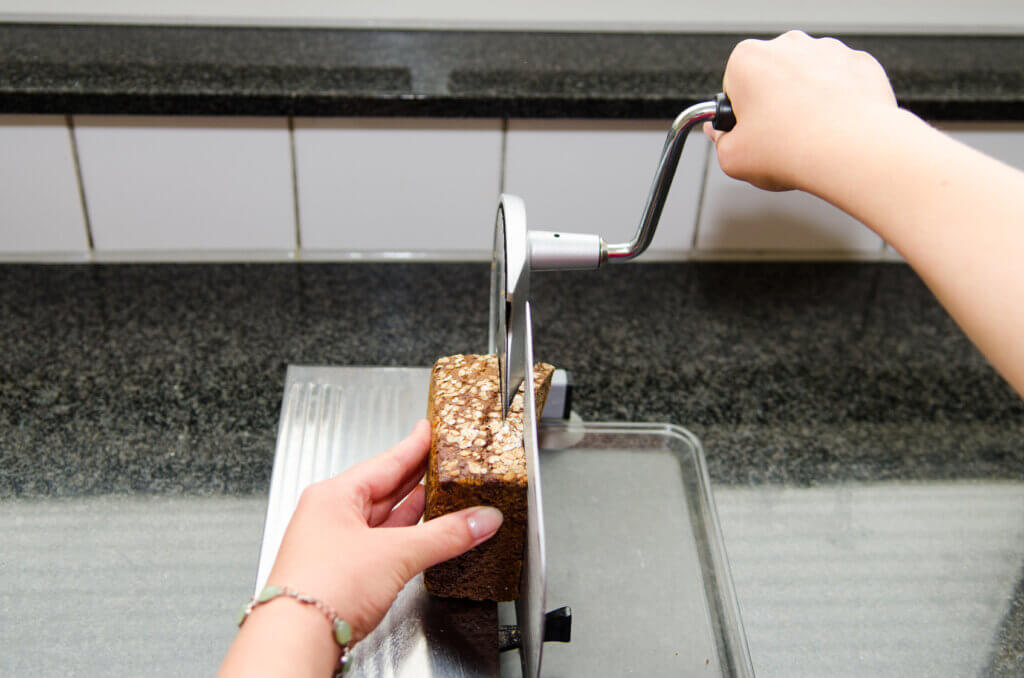
Electric bread slicers
Pro Points
- Convenient operation
- Very hard food can be cut
Drawbacks
- Require electricity
- Higher purchase price
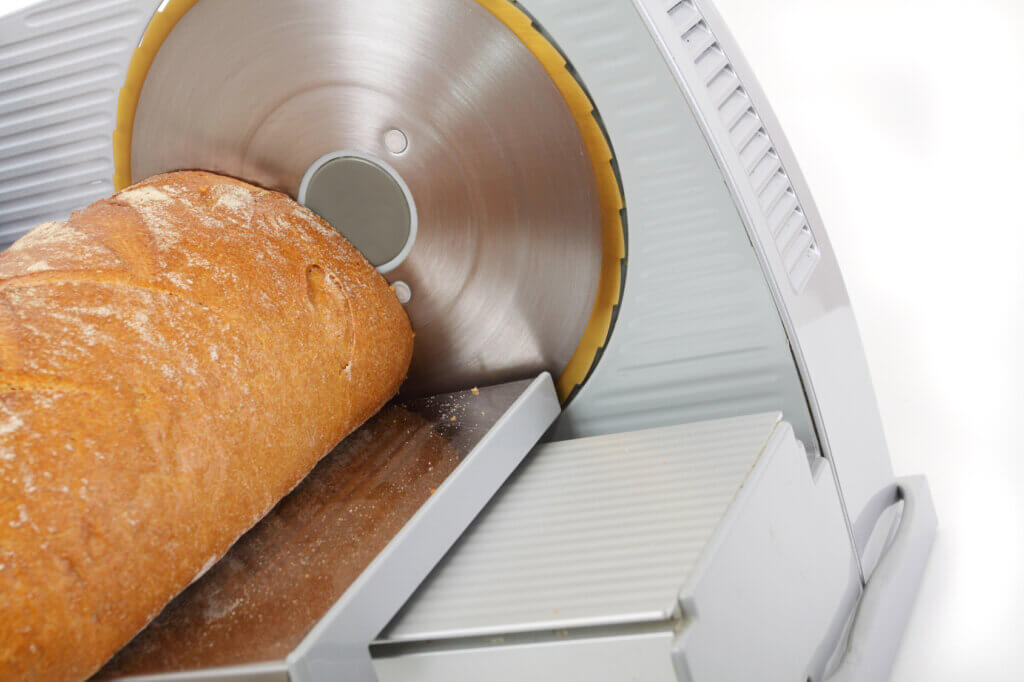
Folding or standing device?
Among the motorised bread slicers, there are again two types. One is foldable and is assembled before use, while the other is a stand-alone unit with a fixed location.
Floor-standing unit
Pro Points
- Stable
- Rubust
- Immediately ready for use
Drawbacks
- Take up a lot of space
- Expensive
Folding device
Pro Points
- Space-saving
- Inexpensive
Drawbacks
- Not very stable
- Mostly very robust
- Assembly can be awkward
For small kitchens and occasional use, a folding device makes perfect sense. If users have little work space available for cutting, the space-saving bread slicers are the better option. However, buyers should pay attention to how the bread slicer is assembled. The joy of the purchase will not last long if they first have to assemble the device in a time-consuming and complicated way. On the other hand, if the slicer is used frequently – for example in a restaurant kitchen – a hard-wearing floor-mounted unit is the best choice.
What makes a good bread slicer?
Motor power
The motor power of the bread slicer is an important criterion for a good appliance. Power levels vary quite a bit from model to model, usually ranging from 45 to 170 watts. When consumers cut very hard foods, for example bread with a firm crust, this places a heavy load on the universal slicer’s motor. All-purpose slicers with eco-motors, which adapt energy consumption to the food being sliced and thus save electricity, therefore have a great advantage. Other slicers, on the other hand, run permanently at a high wattage and thus increase the risk of the appliance overheating. Buyers must also bear in mind that these types of motors are not designed for high performance, but only for domestic use. Some users may also be concerned about how loud the motor of an all-purpose slicer is.
Knife material and sharpening
The most important thing in a good bread slicer is, of course, the blade, because only a sharp, high-quality blade cuts reliably and minimises the risk of injury. A decisive criterion is its material: soft steel is out of place in all-purpose slicers because it is no match for hard bread. Of course, the type of steel should be stainless steel. A titanium coating on the serrated blade provides extra hardness and guarantees that the blades stay sharp and the metal does not wear out too quickly.
Did you know that…
… dull knives pose a higher safety risk? With blunt blades, users tend to squeeze the cut material, causing blades to slip more often.
Most slicers have a serrated utility knife. This serrated blade copes very well with most foods such as bread, sausage or cheese. However, the manufacturers of some appliances also supply interchangeable blades – usually one smooth and one serrated. With serrated blades, consumers cut hard bread crusts more easily, but do not achieve overly aesthetic results with soft cheese. A smooth-ground blade is ideal for this.
Cutting width adjustment
In order for the aroma of the various foods to develop optimally, the right cutting thickness of the slices plays a decisive role. Users determine the correct cutting width on the food slicer itself with an adjustment wheel. The cutting width can be precisely regulated with the help of a millimetre scale. The cutting thickness usually ranges from 0.1 to 23 millimetres, so a good slicer will cut even the thinnest slices without any problems – for example, for beef carpaccio.
The housing material
When it comes to the external values of a bread slicer, it is not only the design that should be decisive, but also the material of the housing. In principle, the heavier the appliance, the greater its stability. A low-priced bread slicer made of light plastic slips more easily and should therefore have suction cups or other holding devices to ensure safety when slicing. Bread slicers made of aluminium usually not only look more elegant, but are also much more robust and stable.
Safety first
An appliance with knives naturally also harbours some sources of danger. To ensure that consumers can handle their machine safely, several safety measures are integrated into a good machine. One basic function is the so-called switch-on safety device. Some machines start immediately as soon as the user presses the start button. With others, the switch-on lock is so awkwardly positioned that you almost have to reach into the running blade to trigger it.
Two separate buttons are best. If the bread gets smaller and smaller as you slice it, your fingertips will get closer and closer to the blade. For such cases, there is the remnant holder, in which the sliced product is cut without the user hurting himself. With a remnant holder, a perfect cutting result is achieved right down to the last cut. A removable blade cover not only protects the fingers, but also ensures that users need even less force when cutting and that the cut material slides past the blade more easily. However, this option is usually only available on the more expensive all-purpose slicers.
Child safety lock
A stand mixer is certainly exciting for children, but it is also very dangerous. Therefore, they should generally not have access to such appliances. A child safety lock reduces the risk of injury. One such measure can be bread slicers with a hidden start button or a lock on the guide rail. When transporting the bread slicer, users must also be careful not to touch the blade or even drop it. Another useful function is the thermal and overload protection. If the motor encounters hard cut material and overheating is imminent, the bread slicer switches itself off automatically. Before the motor of the bread slicer can be started up again, the motor must first cool down.
During use, the machine’s mains cable must of course never come close to the serrated blades. Users can store the cable conveniently and safely in an integrated cable reel compartment on many machines. Despite the safety features, the consumer is not absolved of his own responsibility. Concentrated and careful handling of the cutter should be a matter of course.
Useful additional functions
The angle of inclination makes cutting much easier. With so-called tilting cutters, consumers can tilt the cutter forward by up to 30 degrees. This increases the pressure of the cut material on the blade. As a result, the slices fall out more evenly. A switch for continuous operation lets the serrated blades run on their own without owners having to hold down the start button. Those who do a lot of slicing with the bread slicer will find this function of the all-purpose slicer helpful and time-saving. However, extreme caution is required during this operation: The rotating blades must not be left out of sight.
Accessories
In addition to the universal blade, some manufacturers also supply special blades that are suitable for sausage, cheese or meat. A collecting tray that holds the finished slices is usually included in the scope of delivery. However, users can also buy these cheaply from retailers or simply use a plate.
Depending on how often the bread slicer is used, the blades of the slicer will naturally wear out and lose their sharpness. The owner then has to sharpen the blades of the universal slicer or replace them completely. Some manufacturers offer special blade sharpeners for their products. This allows owners to sharpen the bread slicer’s blade themselves. Detailed instructions on how to do this not only make it easier for beginners to use, but also reduce the risk of injury. If you are not confident enough to do it yourself, you can dismantle the knives and take them to a professional knife or tool sharpening shop. An ideal service is offered by companies to which customers can send their knives for sharpening by post. Alternatively, owners can buy individual blades new and replace the worn ones with them.
For whom is which bread slicer suitable?
For families
As a rule, a bread slicer is used almost every day in families – for dinner together, for break-time sandwiches or for the children’s birthday party. The advantage of an all-purpose slicer is not only that foods such as bread and sausage stay fresh longer, but that families save a lot of money and protect the environment at the same time. After all, if you buy food in one piece, you usually get it cheaper and with less packaging waste. Especially when using the bread slicer in the family, a child safety lock is important, so the appliance should at least be equipped with a safety switch.
For gourmets
Gourmets enjoy many different specialities – from Italian Parma ham to soft French Camembert. The right bread slicer should therefore not only slice bread, but above all be able to cope with foods of varying hardness. For soft cheese, for example, a serrated blade is less suitable – a slicer with a smooth blade is the right choice here. Since the perfect cut has a decisive influence on the flavour of the food, not only the right blade plays an important role, but also the regulation of the blade speed. In general, the softer the food to be cut, the slower the blade rotation of the universal slicer.
For students
Students usually prefer an inexpensive entry-level model with a universal blade, which is mainly used for cutting bread. In a small kitchen in a student flat or shared flat, there is usually little room for large floor-standing appliances. Therefore, a compact, foldable appliance is a practical option. If you have little work space available, you can install your model in a conventional kitchen drawer. This way, the machine is stored safely and in a space-saving way.
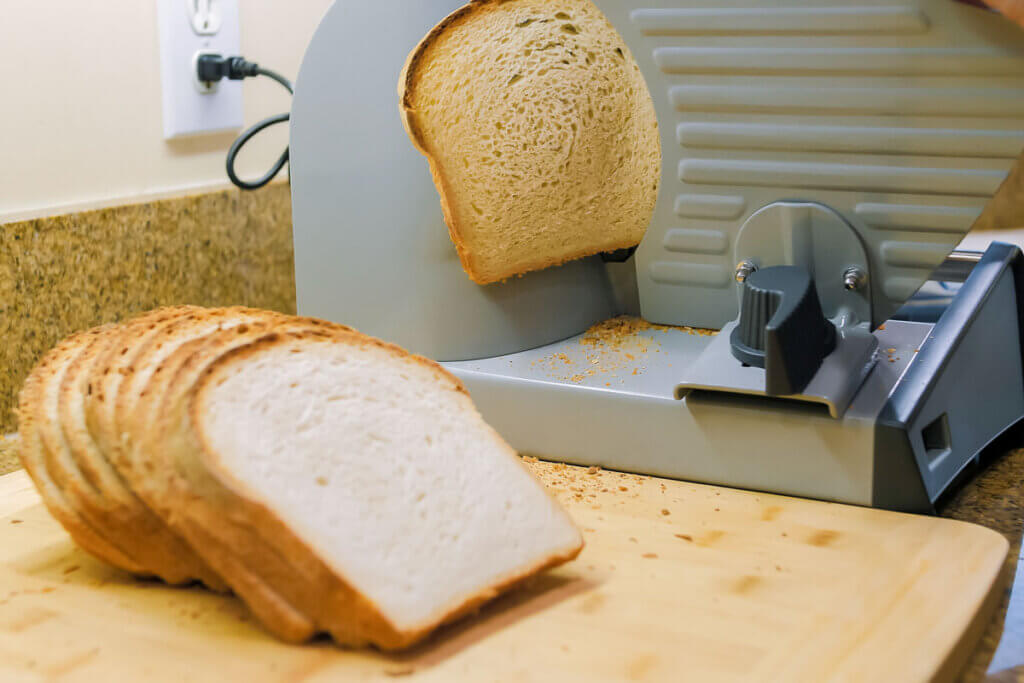
For left-handers
As a rule, left-handers can also use the machines for right-handers without a higher safety risk. Nevertheless, there are also special machines for them. The blades of these all-purpose slicers are on the left-hand side, so that the user guides the food to be sliced to the blade with the left hand and operates the buttons of the all-purpose slicer with the right hand.
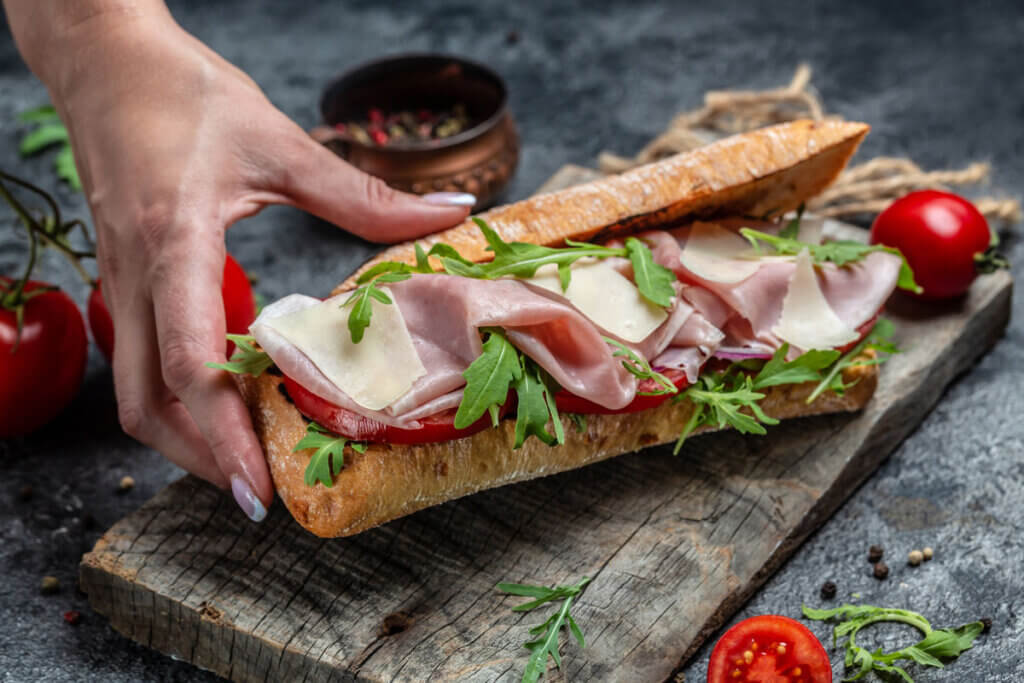
Cleaning bread slicers properly
After using the bread slicer, the question naturally arises of how to clean it for the next use. When buying a bread slicer, consumers should make sure that it is easy to clean. Can individual parts be easily removed and cleaned? It is usually sufficient to carefully wipe the universal slicer with a damp cloth and, if necessary, a little washing-up liquid. By the way, the blades must not be immersed in water. Afterwards, consumers must dry the bread slicer’s blades so that rust does not form on the blade surfaces.
Tip:
If you cut salty foods such as cured meat, clean the knife immediately after use if possible, as the salt solution attacks the steel.
Important purchase criteria: What do you have to look out for?
Price-performance
The cheapest bread slicer is available from about 30 euros, but the majority of products range between 100 and 200 euros. There are no upper limits, even for all-purpose slicers. Of course, the price depends on the operating mode of the model. A manual slicer costs less than an electric model.
If you attach great importance to stability and durability when buying a bread slicer, you should pay attention to what material the housing is made of. Stainless steel is of course more robust than plastic. The weight also determines the stability of a device. Buyers should also consider in advance how much space they have available for the new universal slicer. A folding appliance is ideal for small kitchens. If you have a lot of free work space and use the bread slicer frequently, you are better off with a sturdy floor-mounted unit.
Function
As a rule, bread slicers are equipped with a serrated universal blade that can cope adequately with all kinds of food. For optimal cutting results, however, users need differently ground blades. The cutting width adjustment should not be missing from any machine. A machine that can cut very thin slices of ham as well as thick slices of bread is the best option.
Safety
A high-quality bread slicer features several safety settings that minimise the risk of injury. Is the machine equipped with a switch-on safety device that ensures that the blades of the all-purpose slicer only rotate when the user is cutting? A practical remnant holder protects the fingertips as the food gets smaller and smaller. Electric slicers should definitely be equipped with overheating protection so that the motor switches off automatically if the user overexerts himself. How well is the appliance protected from children’s hands? The best way is to lock the guide rail, have a blade cover and a hidden start button.
Operation
The way the bread slicer is operated is crucial. Is cutting made easier, for example, by an angle of inclination? For longer use, a switch for continuous operation on the bread slicer is useful, because this way users do not have to restart the motor again and again. Furthermore, a look was also taken at whether the cleaning of the devices is easy to manage. Owners should be able to easily remove the blades and the carriage of the bread slicer from the housing and clean them. Technical problems or general questions arise when using all-purpose slicers. For such cases, the manufacturer should offer a clear and detailed manual.
Accessories
Of course, it is particularly praiseworthy if the manufacturer includes several blades and a collecting tray with the bread slicer so that users can use the right blade for every occasion. Most devices only have one universal blade. It is better to have a serrated blade for bread and a smooth blade for sausage and cheese. A collection tray that holds the sliced food is very practical and should not be missing from any universal slicer.
Fig. 1: © Racle Fotodesign / adobe.stock.com | Fig. 2: © K.-P. Adler / adobe.stock.com | Fig. 3: © The Toidi / adobe.stock.com | Fig. 4: © Надія Коваль / adobe.stock.com

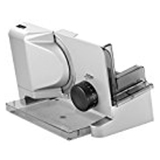
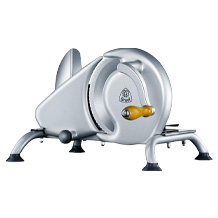
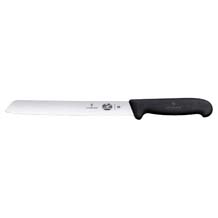
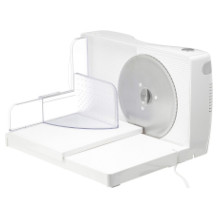
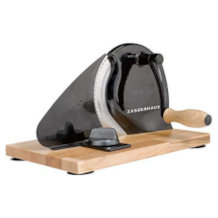
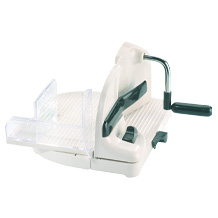
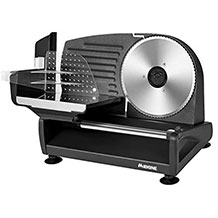
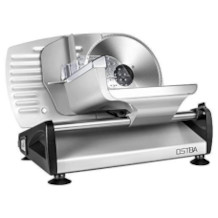

 2,200 reviews
2,200 reviews

